
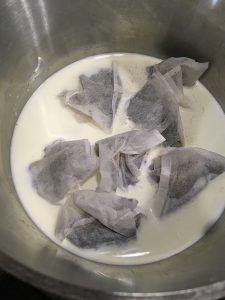
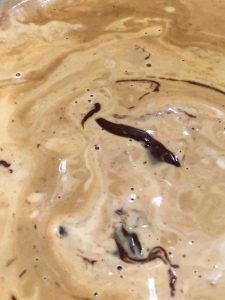
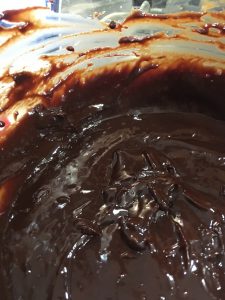

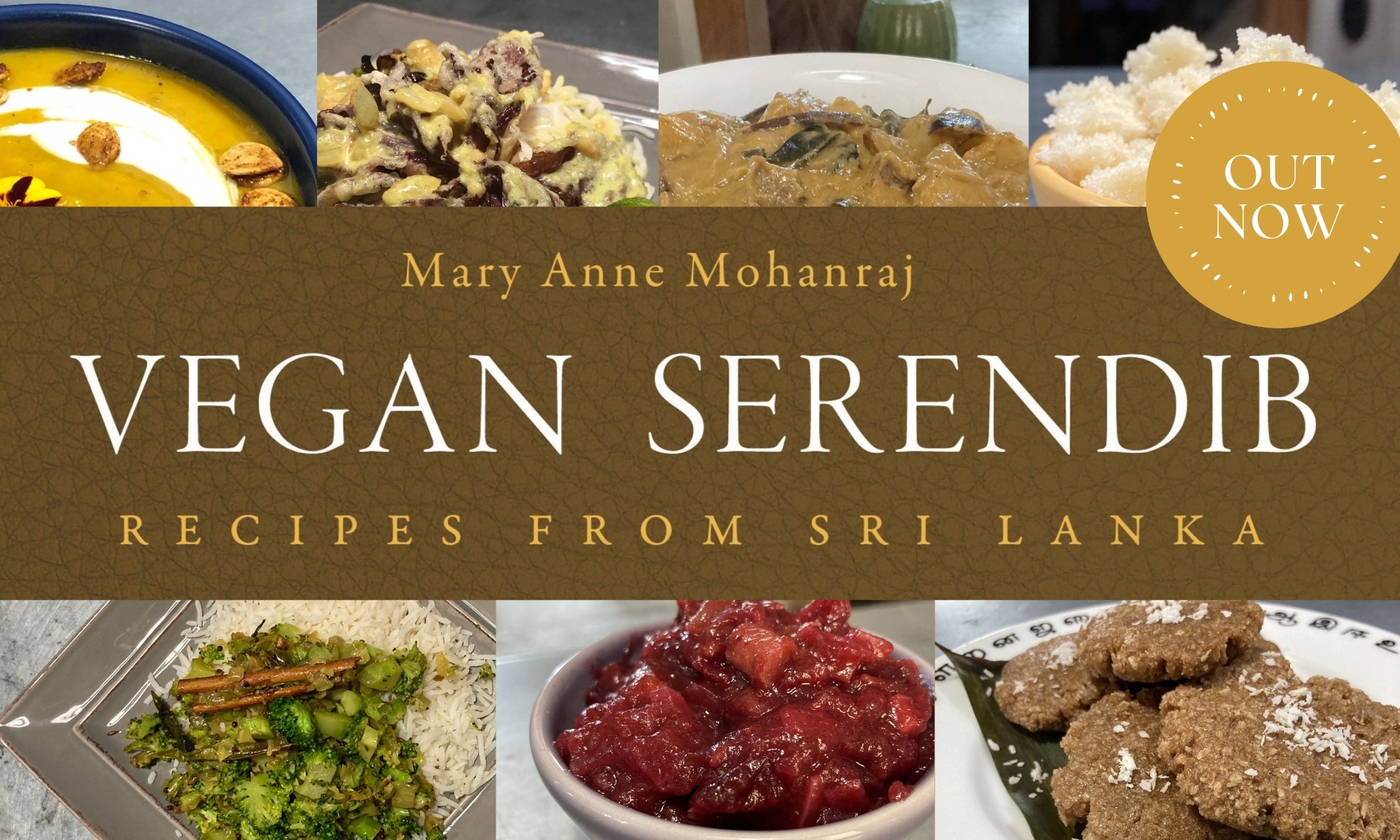
with Mary Anne Mohanraj





I have to admit, I got a little sentimental making cutlets with Kavya this year. I think it’s the first time she and I have done this together, and it reminded me so much of all the years sitting with my mom and sisters and aunts before a party, making these. I told her that, and she said, “So it’s a tradition?” And I said yes. She’s a proper Sri Lankan girl now, even if our cutlets aren’t as perfectly rolled (or the onions as finely diced) as my mother’s would have been.
Fish (or Ground Beef, or Vegetable) Cutlets
(90 minutes, makes about 50)
There’s a part of my mind (formed in childhood over monthly Sri Lankan birthday parties at various aunties’ homes) that says a party isn’t properly a party unless there are rolls and cutlets. So when people agree to come over to my house and let me feed them rolls and cutlets, it makes that childhood bit of me very happy.
Some Americans find these too fishy, but I love them. Over the years, my family has come up with adaptations to suit the tastes of those (like Kevin) who dislike fish, and they’ve even come up with a variation for vegetarians. But honestly, the mackerel ones are the tastiest.
I wouldn’t recommend attempting this recipe unless you’re willing to get your hands dirty (and fishy-smelling)—you really need to work the filling with your hand to blend and shape it properly.
2 cans of mackerel, 15 oz each
2 large russet potato
4 medium onions, chopped fine, for sautéing
1 tsp black mustard seed
1 tsp cumin seed
2 TBL oil or ghee
1 rounded tsp salt
2/3 cup lime juice
2 small onions, minced, for mixing in
4 rounded tsp finely chopped fresh Thai green chilies
1 rounded tsp ground black pepper
2 egg, beaten
dry breadcrumbs, for coating
oil for deep frying
1. Drain fish thoroughly, removing as much liquid as possible. While fish are draining, boil the potatoes, peel, and mash them. Clean the fish, removing scales and bones, and break it into small pieces.
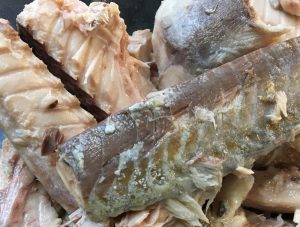
2. Sauté the four fine-chopped medium onions in oil with cumin and black mustard seed until golden-translucent. Add fish, salt and lime juice, then cook until very dry (this process reduces the fishy smell, and the drier you get the mixture, the less excess oil they’ll pick up when frying). Let cool.
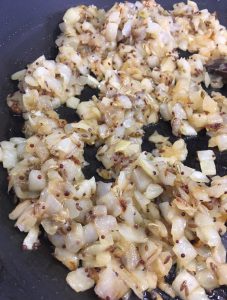
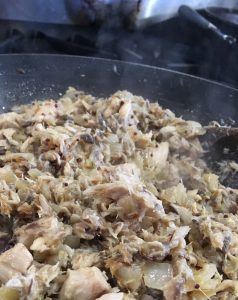
3. Using your clean hand, mix thoroughly the fish, mashed potatoes, the two small minced raw onions, black pepper, and chilies until a fairly smooth paste. Shape the mixture into small balls, about the size of a cupped palm. I squeeze the mixture in my balled hand as I go, compressing so the resulting ball is nice and firm—that helps it keep its form when frying. (You can pause, cover with plastic wrap, and refrigerate at this point if making a day or two ahead.)

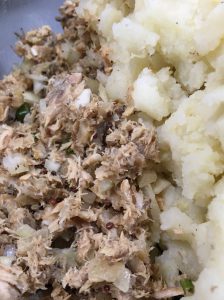
4. Roll each ball in beaten egg, and then roll each ball in the dry breadcrumbs. (You can freeze at this point if making ahead—spread them out on a flat cookie sheet so they’re not touching and freeze them—once frozen, you can pack them more tightly in gallon ziploc bags, and they should hold their shape. They’ll be fine in the freezer for weeks, which helps when you’re prepping for a big party; you can either fry them frozen or spread them out on plates and let them thaw first.)

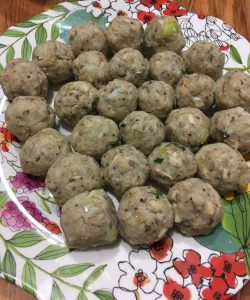

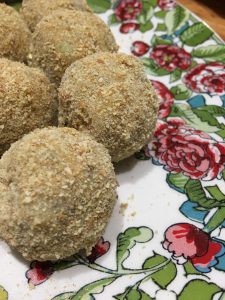
5. Fry a few at a time in deep hot oil over medium-high heat—not too hot, or they’ll start to break apart! This should take a minute or so each. When well-browned, lift out with a slotted spoon and drain on a metal rack placed over a tray lined with a few layers of paper towels.
For ground beef cutlets: For 2 lb lean ground beef, when you sauté the 4 chopped onions, add 1-2 heaping tsp red Indian chili powder and 1/2 cup ketchup, as well as the 1/2 rounded tsp salt from above. Add the ground beef (skipping the lime juice), and fry until very dry, draining any excess oil. Skip the raw onion, chilies and black pepper—proceed otherwise as for the fish cutlets.
For vegetable cutlets: Just use 1 lb frozen mixed vegetables, thawed (you might have to cut up the green beans into smaller pieces). Sauté the onions, mustard seed, and cumin seed as for the fish; add the vegetables and salt and cook until very dry. Skip the raw onion if you like, but definitely stir in an extra 1/2 tsp of salt when you mix the veggies in with the potatoes, black pepper and chilies. Proceed otherwise as for the fish cutlets.
When you want curry for breakfast but you don’t have curry so you start to get sad but then you remember you have a jar of seeni sambol and you put on toast and fry two eggs and eat them with seeni sambol and you are happy again.
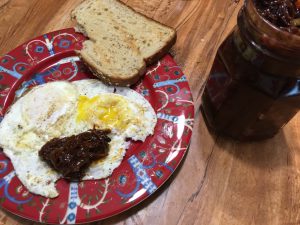
Sweet Onion Sambol / Seeni Sambol
(1 hour, serves 8)
The Sri Lankan version of caramelized onions is sweet, spicy, and tangy. It’s important to cook the onions slowly—all the liquid in the onion must evaporate if you want the sambol to keep well. Made properly, this dish can keep for several weeks in the fridge, so you can enjoy a little with each curry meal for quite a long time. An essential accompaniment for hoppers, and delicious with many other meals.
1/2 cup vegetable oil
1 TBL Maldive fish, powdered (optional)
4 medium onions, finely sliced
2 rounded tsp chili powder
1 inch cinnamon stick
3 cloves
3 cardamom pods
1 stalk curry leaves
1 tsp salt, or to taste
2 TBL tamarind pulp
2 TBL sugar
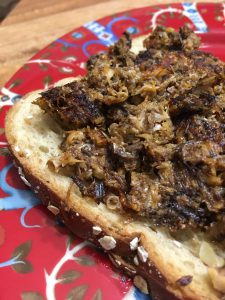
 Made it again, and this version is the winner, I think — it holds together beautifully, and tastes delicious. There’s just a hint of lemon flavor; the mango and ginger notes dominate. Kavya said when we were baking last night, “It looks like Sri Lankan food!” She has come to believe that Sri Lankan food is mostly yellow and orange, which is not entirely true, but not entirely wrong in this case, since this is a pretty Sri Lankan-flavor-inflected shortbread.
Made it again, and this version is the winner, I think — it holds together beautifully, and tastes delicious. There’s just a hint of lemon flavor; the mango and ginger notes dominate. Kavya said when we were baking last night, “It looks like Sri Lankan food!” She has come to believe that Sri Lankan food is mostly yellow and orange, which is not entirely true, but not entirely wrong in this case, since this is a pretty Sri Lankan-flavor-inflected shortbread. ![]()
2 sticks unsalted butter (1 c.), chopped coarsely
3/4 c. sugar
1 t. salt
zest of one lemon
1/2 t. lemon extract
2 c. flour
1/3 c. crystallized ginger, chopped fine
1/3 c. dried mango, chopped fine
1. Preheat oven to 300.
2. Cream butter, sugar, salt, lemon zest, and lemon extract until well blended. (I use an electric hand mixer for this.)
3. Add flour and beat until it consolidates into a very crumbly dough.
4. Gently stir in ginger and mango.
5. Press into a molded shortbread tin and bake 20 minutes. Unmold, slice apart into separate cookies, and let cool.
Delicious with a nice cup of tea!

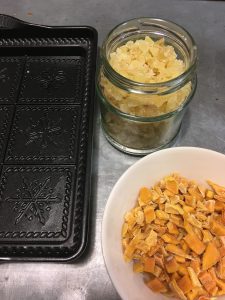 This one is barely a recipe — more of an experiment. This is Kevin shortbread, because he loves shortbread, mango, and ginger. We used the King Arthur Flour shortbread recipe, and mixed in half a cup of mango pieces and half a cup of crystallized ginger pieces.
This one is barely a recipe — more of an experiment. This is Kevin shortbread, because he loves shortbread, mango, and ginger. We used the King Arthur Flour shortbread recipe, and mixed in half a cup of mango pieces and half a cup of crystallized ginger pieces.
Kev and I both found it delicious, but it didn’t hold together quite as well as I would have liked, I think because I typically only fill my shortbread pan halfway deep, so I get 18 reasonable sized cookies out of a batch instead of only 9 really big ones. But for this recipe, it might have worked better to just go for it with the big cookies. ![]()
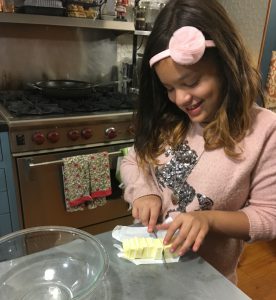
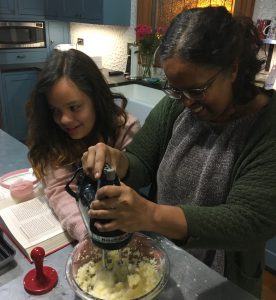
Alternately, I think you could reduce the amount of mango and ginger to a 1/4 c. of each, and the cookies would hold together better. Still, yum. The trick will be not eating them all before our holiday party on Sunday. The way shortbread cookies melt in your mouth, leaving that last little salt-butter lingering…

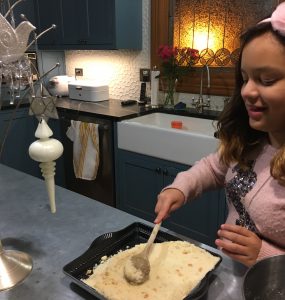
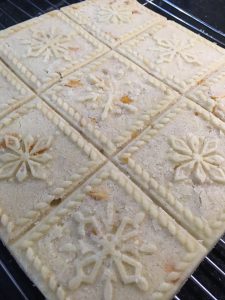

Kale Sambol
(20 minutes, serves 8)

I had never been a big kale fan, but my friend, Roshani, completely converted me with her Aunty Indranee’s use of kale in this traditional sambol. In Sri Lanka, this would have been made with a native green, gotu kola, but kale is an excellent substitute (you can also try any other leafy greens, like beet greens, mustard greens, or rainbow chard).
For this preparation, kale is chopped small and tenderized with lime juice. When mixed with the coconut, tomatoes, sugar, and salt, the result is a tasty and addictive sambol that has become an essential component to many of our meals — if I make a meat curry now, I almost always make kale sambol to accompany it, and will often eat more sambol than curry. I’d have it with a little rice, but Kevin likes to just have beef curry and kale sambol together in a bowl, or with steak on a plate, which is also delicious.
1 bunch kale, leaves stripped off (stems discarded)
1 medium onion, minced
1 cup shredded unsweetened coconut
1-2 cups cherry tomatoes, chopped
Juice of 2 small limes (about 2-3 TBL)
1-2 TBL sugar
1 tsp fine salt
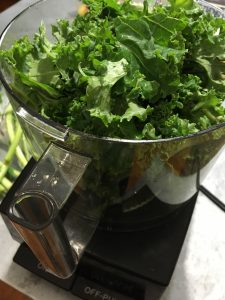

Can be served immediately, but best if allowed to sit and blend for an hour or so. Will keep in fridge for a good week—refresh with a little extra lime juice as needed.
Grilled Spice-Rubbed Steak
2 lbs. flank steak, cut into a few pieces against the grain
3 garlic cloves
1.5 t. kosher salt
2 T vegetable oil
3 t. Sri Lankan dark roasted curry powder
1 t. black pepper
1. Mince garlic and mash to a paste with salt. Add oil and spices and stir to a paste. Pat steak dry, then rub all over with paste (easiest with your clean hand). Marinate steak at least two hours, or longer, up to a day.
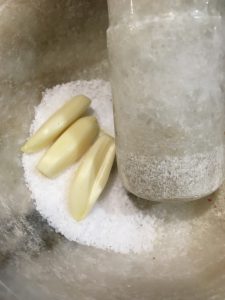
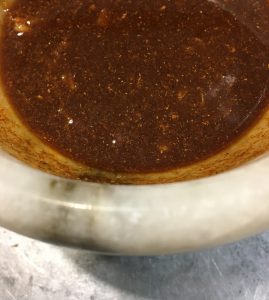
2. Heat grill to medium-high, and grill steak on lightly-oiled grill rack, uncovered, turning over once, 6-8 minutes total for medium-rare.
3. Let rest 5 minutes, then cut steak diagonally across grain into 1/4-inch-thick slices.
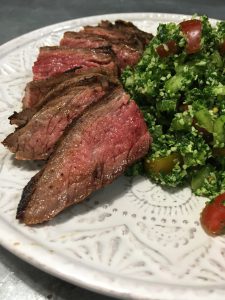
I probably should’ve taken it easier today, eaten leftovers instead of trying to cook, but I had told Kevin that I’d make steak and kale salad while he had a long day on campus, and I wanted to have that for him. So even though I had done computer work all day (catching up on overdue things from surgery time, getting the new website up and running), and was feeling exhausted, I powered through and made the food (leaving the kitchen something of a disaster).
It’s all tasty, but I think both Kev and I would agree that leftovers would have been the wiser choice. Sometimes I get an idea in my head, and I have a really hard time scaling it down to something more practical, and then I fall down.
We’re trying to get the whole family to eat a little healthier, as we all have something of a genetic tendency to plumpness (and also like sitting around way too much of the time with our devices, which is another thing to work on, but that’s another problem…) But the kids are still very dubious of much of our food, esp. anything spicy. If we’re cooking two separate meals, pizza and pasta for the kids are so easy, but they really could use a more varied diet (with more appreciation of vegetables). It’s going to be a bit of a challenge, making the time. Important, though. Going to have to strategize.
My secret wish is to make time to start cooking twice a week with Kavya in a very focused way — ideally, one Sri Lankan recipe / week, which she may or may not like, and one American recipe that she is almost certain to like. The very ambitious version of this would have me recording video and audio and then using some of it for either podcast or little website videos.
But that may be more than anyone has energy for, esp. given how time-consuming editing is — if I just cook with her, that’s the important part. A resolution for next New Year? We’ll see. Maybe the new website will help.
When I’m sick, apparently I revert to cooking the simplest foods. Deviled potatoes is one of the first dishes I learned how to cook, twenty-five years ago. I’ve learned how to make much fancier food since then, but I still am perfectly happy eating a big bowl of these — sometimes with rice and other curries, sometimes just straight up.

1. Sauté onions in oil on high with mustard seed and cumin seeds until onions are golden/translucent (not brown). Add chili powder and cook 1 minute. Immediately add potatoes, ketchup, and salt.

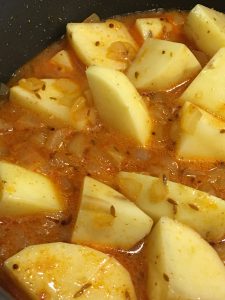
2. Lower heat to medium and add enough water so the potatoes don’t burn (enough to cover usually works well). Cover and cook, stirring periodically, until potatoes are cooked through, about 20 minutes.
3. Remove lid and simmer off any excess water; the resulting curry sauce should be fairly thick, so that the potatoes are coated with sauce, rather than swimming in liquid. Add milk, if desired, to thicken sauce and mellow spice level; stir until well blended. Serve hot.